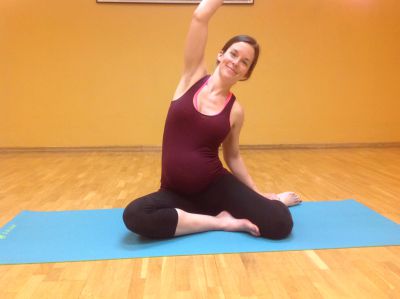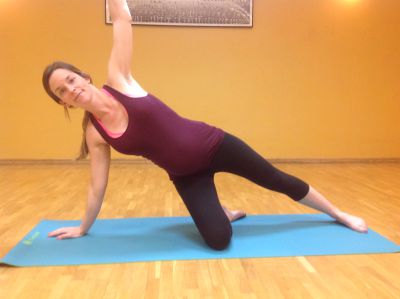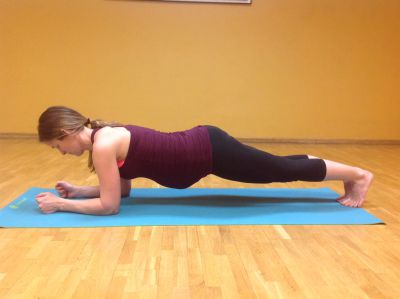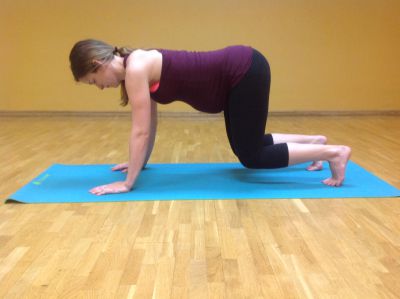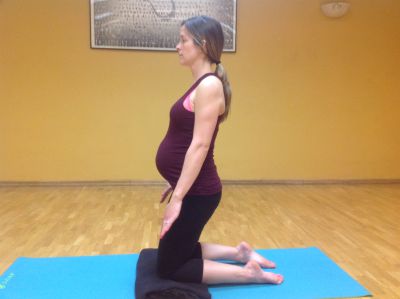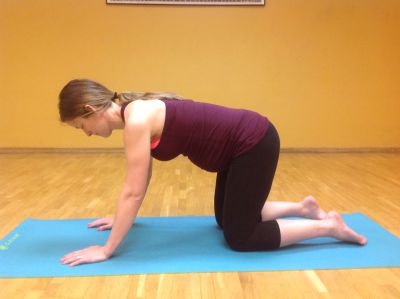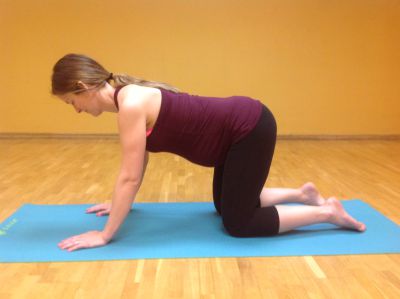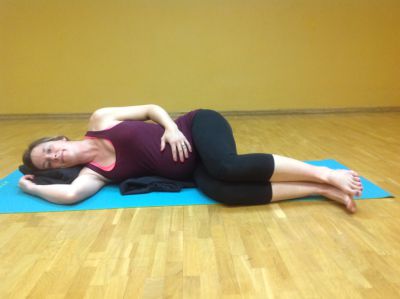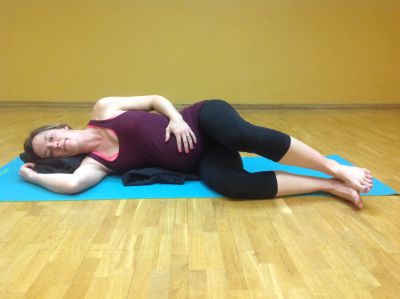
There are many unwanted side effects that can happen during pregnancy including change of postural alignment, loss of muscle tone, back pain, poor sleep, edema, collapsing foot arch, etc. Pilates can help combat and avoid all of these and more as well as ultimately help with labor and delivery.
– Dina Voigt
Pilates for Pregnancy
by Dina Voigt
It is a well-known fact that Pilates is one of the best ways to prepare your body for pregnancy and also one of the best ways to get back into shape after pregnancy. What about DURING pregnancy? Due to the fact that Pilates is a low impact workout that improves postural alignment that increases flexibility and strength, it is a safe and fabulous exercise option for pregnant women. There are many unwanted side effects that can happen during pregnancy including change of postural alignment, loss of muscle tone, back pain, poor sleep, edema, collapsing foot arch, etc. Pilates can help combat and avoid all of these and more as well as ultimately help with labor and delivery. The breathing techniques can also help to elevate energy levels and help boost your mood! Pilates is such an adaptable form of exercise that can be modified to accommodate your needs as your body changes throughout the pregnancy.
The benefits of Pilates on the body are truly limitless. For purposes of this article, I am going to touch on just a few important points that make Pilates so great for pregnancy.
1. Strong Core
Pilates focuses on strengthening the deep, core, postural muscles of the body, including the transverse abdominals, obliques and your deep back muscles. The transverse abdominals are one of the deepest layers of the abdominals and they function much like a corset that supports your trunk and internal organs. During pregnancy, as the baby grows, if the back muscles and deep abdominals are weak, the body adapts to a “sway back” type of posture, pulling the pelvis forward and under. This postural change not only strains the lower back and pelvic floor, but also the hips, knees and feet. Strengthening these muscles before and during pregnancy can relieve pressure on your back and lower extremities and teaches your body to support the baby weight and adapt as the baby grows throughout the pregnancy.
2. Pelvic Floor
Pilates strengthens the pelvic floor. This group of muscles deep inside your pelvis works to keep your organs (and baby) from being pulled down by gravity. It the pelvic floor muscles are weak before pregnancy, they can still be strengthened during pregnancy with specific Pilates exercises. Pilates teaches you how to “activate and deactivate” the pelvic floor muscles, or “contract and release” them. This is extremely helpful during delivery. Strong pelvic floor muscles are also essential in helping the body return more quickly to its pre-pregnancy state as well as preventing incontinence.
3. Breathing
Pilates incorporates full, deep breathing techniques which helps activate the transversus abdominus to contract. This helps pull, or draw the belly in during most of the exercises, which in turn provides integral support to the back. The breathing techniques help to co-contract the flexors and deep extensors of the body which in turn encourages centered postural alignment as well as strengthening of the entire internal core mechanism. Other Pilates breathing techniques help to develop movement and flexibility in the intercostal muscles (think of them as the muscles between the ribs). As we take, deeper, fuller breaths, the ribs need to expand in order for the lungs to fill with air. Flexibility in the intercostal muscles allow for this movement to happen naturally with breath. This is extremely important for pregnancy as the baby starts to grow and take up more space in the abdominal cavity. and…Of course…proper breathing aids in labor and delivery! Many of my clients swear that their “Pilates” breathing helped them immensely during their labors and deliveries!
4. Upper Back and Arm Strength
Not only are upper back and arm strength important during pregnancy, they are extremely important after the baby is born. During pregnancy, upper back strength is so important to help support the weight of growing breasts and baby on the front of the body. If the upper back muscles are weak, the upper body begins to hunch forward into a “hyper-kyphotic” or “hunchback” position. Once the baby is born and nursing begins, holding and swaddling and attending to the needs of the baby, encourages this hunched over posture, which in turn has negative effects on the rest of the body. Arm strength, goes hand in hand with the upper back strength, holding and carrying the growing baby.
5. Balance and Postural Awareness
A comprehensive Pilates program incorporates all of the points mentioned above as well as improving balance. It goes without saying that as the baby grows, the body is constantly trying to adapt. Pilates strengthens all the deep stabilizers, bringing awareness to proprioception or “where we are in space”, and teaching the body how to adapt to these changes with ease and grace. It decreases and even eliminates back pain and avoids permanent imbalances after the baby is born.
6. Flexibility
The aforementioned changes in the body during pregnancy can cause the hip flexors, neck extensors chest and lower back to become excessively tight, which causes compensation, and opposing muscles become weak. Again, Pilates can minimize and even prevent these negative changes by incorporating dynamic and static stretches into your pregnancy routine.
If you are planning to become pregnant, there is no better time to begin practicing Pilates than NOW! If you are already pregnant, you can still safely incorporate Pilates into your life. If you attend a group class, please inform the instructor and she/he can give you modifications to fit your needs, and keep you and your baby safe.
Let’s hear from Heather Neary:
About 8 years ago I began my Pilates journey with Dina. I was skeptical at first, but I was intrigued by all the buzz I was hearing around this Pilates practice. For me, it was the best decision I made for my body. Shortly after beginning my new pilates regimen, I became pregnant. Dina began to tailor my workouts to strengthen the muscle that tend to weaken during pregnancy. We worked for months on tightening my core muscles. I swear that all the work made my delivery a cinch! About eight weeks after giving birth, I was back at Pilates. I was amazed how easily my core muscles recovered. My abs began to flatten and tighten way quicker than I would have thought. Although this was great, the highlight was the confidence that going back to pilates gave me. It made me feel strong. I continued with Pilates through the birth of my second child with the same amazing results; an easy delivery, a strong body and mind. To me Pilates is a must before, during and after pregnancy!
And from Jessica Stankard (pictured demonstrating the various poses):
I began taking Dina’s mat Pilates classes about 4 to 5 years ago at Fitness Incentive. Since then, on a personal level, it has made me a stronger endurance runner and has kept my core, posture and body awareness strong throughout my current pregnancy. On a professional level, as a Physical Therapist, I find myself prescribing my patients many Pilates exercises and teaching them the same concepts I’ve come to learn in class. It’s a wonderful and challenging foundation of strengthening that can be tailored to fit any age, activity level or rehabilitation from injury. I would encourage anyone looking to increase their core strength, reduce low back pain and improve daily posture and body mechanics to take a Pilates class. The health benefits are real and long-lasting!
Private Pilates sessions are also a wonderful option for you during your pregnancy, as your PIlates trainer will design and develop your routines specifically to adapt to your body as it changes throughout the pregnancy.
Remember to ALWAYS CONSULT A PHYSICIAN BEFORE BEGINNING ANY NEW EXERCISE
A few things to keep in mind and avoid:
1. Medical experts advise not exercising on your back once you are in your second, or third trimester. The Vena Cava is the main vein that carries blood from your lower body to your heart. Exercising in a supine (lying on your back) position for a prolonged period of time can compress the vena cava which can interfere with the circulation of both you and the baby. Many supine Pilates exercises can be modified by propping yourself up in a supported supine position.
2. Do not lie on your stomach.
3. Be aware of excessive rectus abdominal work into your third trimester. Avoid traditional “crunches” where you are lifting your head forward and curving your spine forward into deep flexion. This can create a separation of the connective tissue (linea alba) of the rectus abdominus, called Diastasis Recti. Although in most cases, diastasis can be “repaired” post-pregnancy, it takes a lot of work and it is best to take precautions during your pregnancy and do the best you can to avoid it happening in the first place.
4. Avoid any inversion exercises where your pelvis moves above your heart.
5. Be careful of over stretching. During pregnancy, a hormone called “relaxin” is released in the body. Relaxin loosens the ligaments in the body to help the body adjust to the growing baby and to help the hips move during delivery. You must be extra cautious of your “new found flexibility” during pregnancy. if you overstretch your ligaments, you will cause permanent injury. As stated before, it is important to maintain flexibility during pregnancy, but it is not the time to try to work on developing more flexibility or going beyond a reasonable range.
Keeping in mind the precautions above and after getting cleared by your physician, here are a few things you can try at home:
1. Mermaid bend to modified side plank
Come to sit on your right hip with your knees bent to your left. Grab a hold of your left ankle with your left hand. Inhale, reach your right arm overhead, exhale as you lean over to your left side. Hold for one full breath, lengthening and lifting through our ribs as you stretch over, engaging your abs. Come back to center and place your right palm on the floor to your right side. Press into your right palm as you lift off your right hip, coming onto your right shin. Straighten the left leg out pressing into the left foot. Reach your left arm overhead as you lift and lean over to the right. Draw your abs in and “shrink wrap” your waist energy. Slowly return to the start position and repeat 4 to 8 times. Repeat on other side.
2. Forearm plank
Come onto your hands and knees Lower yourself down to your elbows and forearms. You can line your wrists up with your elbows or interlace your fingers, either way, keep your elbows wide. Straighten one leg at a time pressing into the bottoms of your toes and ball of your feet until your body forms a straight line from head to feet. Keep your abdominals drawn in and lengthen your body from head to tail. Press into your forearms lifting energy off your armpits engaging your core and legs to keep body from dropping down of center. Do not let your hips drop below your ribs. Breathe deeply and hold the position for 5 to 10 seconds, eventually building up to 30 seconds. Rest down by sitting on your heels with knees open as needed.
3. Knee hover core control
Come to knees and forearms with elbows shoulder-width apart. Bring your knees under your hips and extend your toes into the mat so you can press into the pads of the toes and balls of the feet. Inhale to prepare, exhale, tighten your abs as you press into the pads of your toes and balls of your feet, and lift both knees at the same time, floating them a few inches off the floor. Hold for 1 full breath while pressing into your forearms and squeezing abs tightly. Lower both knees at the same time. Repeat 4 to 8 times, resting back on your heels in between as needed.
4. Kneeling 100's
Place a flat pillow or a folded blanket under your knees with your knees hip-distance apart ( you can also do these seated in a chair). Square your hips over your knees and your shoulders over your hips, collar bones open wide. Neutralize your spine engaging your abs as you lengthen your arms alongside your body, keeping shoulders back and down. Inhale through your nose for 5 counts as you pump your arms back. Exhale through your mouth for 5 counts contracting your abs as you continually pump your arms. Keep the body stable as you pump the arms with control.
One set equals 10 pumps. Do 5 to 10 sets.
5. Pelvic Tilts
Come to hands and knees. Place your wrists slightly forward of your shoulders and your knees under your hips. Neutralize your spine. Inhale as you arch your back lifting your tailbone and sitting bones up. Then exhale as you tuck your tailbone under and round your back. Draw your abs in and contract pelvic floor muscles. Repeat 8 to 10 times. Rest back to your heels as needed.
6. Clams
Lie on your right side with legs bent slightly in front of you. You can place a pillow or a folded blanket under your head and another flat pillow or a folded blanket under the side of your belly for support. Stack your knees and hips on top of each other and keep your spine straight and abdominals engaged. Your left hand can be on your belly or behind your head. Keep the insteps of your feet touching and lift your left knee off your right only as high as you can without moving your body. Do not roll back on your hips or let your feet come apart. Lower the leg back to the start position. Repeat 8 to 10 times. Switch sides.
Dina Voigt is a certified Pilates, yoga & spin instructor, as well as a certified Personal Trainer. She manages the Mind, Body & Spirit program at Fitness Incentive.

